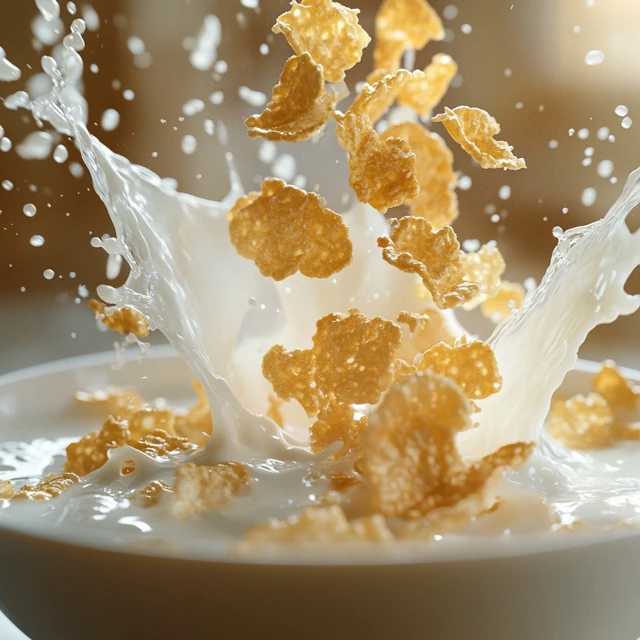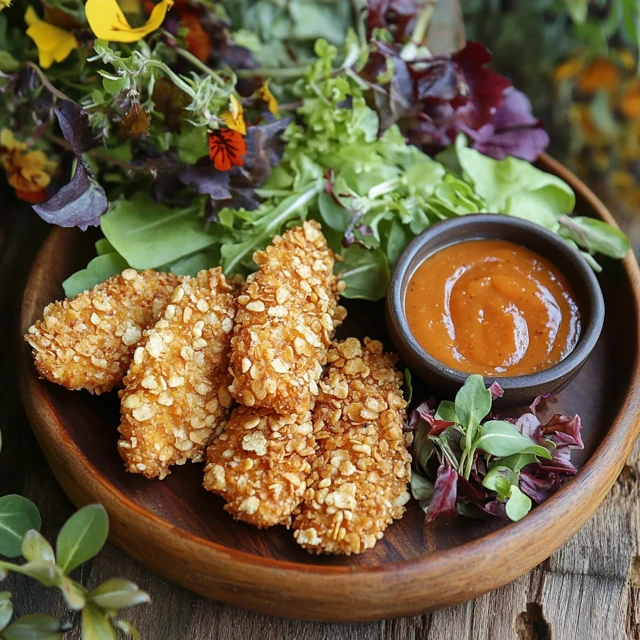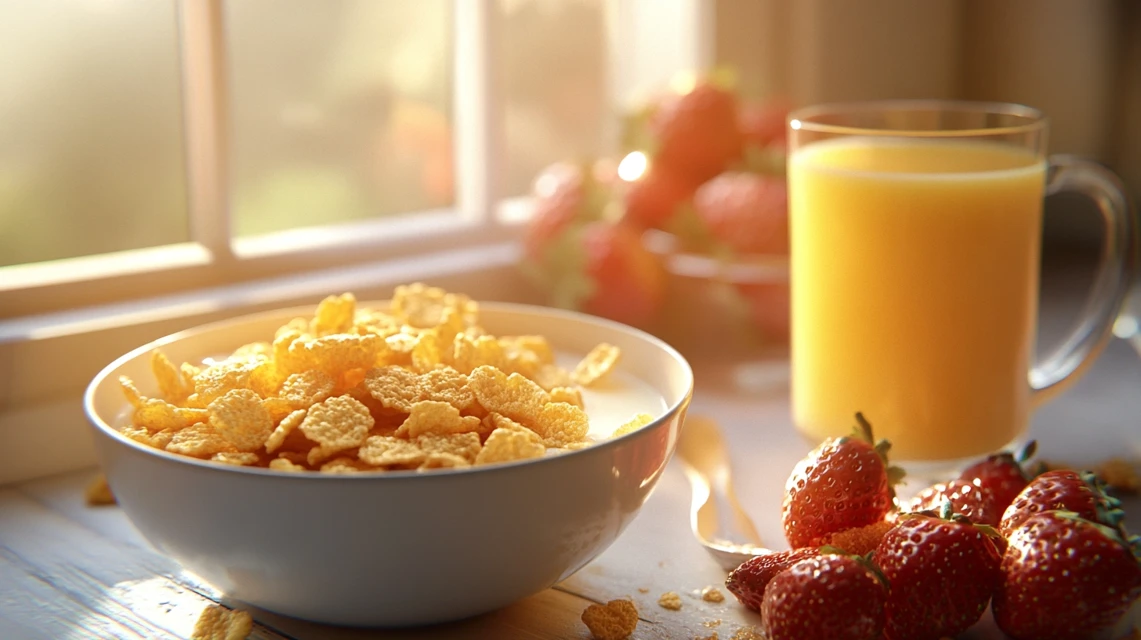When it comes to breakfast, corn flakes have been a staple for generations. They offer a simple yet satisfying start to the day. With a long history and global appeal, corn flakes have earned their spot as a favorite morning meal. But what makes them so popular? Let’s uncover the fascinating history, nutritional value, and versatility of this beloved breakfast option.
The History of Corn Flakes
The story of cornflakes begins with innovation and determination. From their humble origins to becoming a global sensation, cornflakes have truly transformed the way we view breakfast.
check out this https://eassyrecipes.com/category/breakfast/
The Origin Story: How Corn Flakes Were Invented
It all started in the late 19th century when Dr. John Harvey Kellogg and his brother Will Keith Kellogg were searching for ways to promote healthier eating. They accidentally stumbled upon the idea of cornflakes while experimenting with boiled wheat. Although the process didn’t go as planned, the result was a flaked texture that sparked their curiosity. Through trial and error, they eventually switched to corn, which led to the creation of cornflakes. This innovation marked the beginning of a breakfast revolution.
The Role of the Kellogg Brothers in Popularizing Corn Flakes
Dr. John Kellogg saw cornflakes as a part of his health-focused vision. However, it was Will Kellogg’s entrepreneurial spirit that turned cornflakes into a commercial success. By adding a touch of sugar and focusing on mass production, Will made cornflakes appealing to a broader audience. His efforts not only popularized cornflakes but also set the stage for the breakfast cereal industry.
How Corn Flakes Revolutionized Breakfast Culture
Before the introduction of cornflakes, breakfast was often a heavy and time-consuming meal. With the advent of cornflakes, mornings became quicker and more convenient. The light, crispy texture offered a refreshing alternative, encouraging people to embrace healthier and simpler eating habits. Today, cornflakes symbolize a modern, efficient approach to starting the day.
check out this https://eassyrecipes.com/category/breakfast/
Nutritional Profile of Corn Flakes

Understanding the nutritional value of cornflakes is essential for anyone looking to make healthier choices. Packed with key nutrients and versatile in preparation, corn flakes are more than just a convenient option.
Key Nutrients Found in Corn Flakes
Corn flakes are made primarily from milled corn, which is a source of essential carbohydrates. They are typically fortified with vitamins and minerals, including:
- Vitamin D for bone health.
- Iron to support red blood cell production.
- B vitamins for energy metabolism.
These nutrients make cornflakes a balanced option for many diets.
Benefits of Including Corn Flakes in Your Diet
Adding cornflakes to your daily meals can bring several advantages:
- They are low in fat, which supports heart health.
- Their carbohydrate content provides a steady source of energy throughout the morning.
- Fortified cornflakes help bridge nutritional gaps, especially for individuals with specific dietary needs.
Moreover, the versatility of cornflakes allows them to pair well with milk, yogurt, or fruits, making them a customizable choice.
Are Corn Flakes Suitable for All Diets?
While corn flakes are widely enjoyed, they may not fit every dietary preference. For example:
- For those avoiding gluten: Many cornflakes contain malt flavoring, which may include gluten. Gluten-free options are available but require careful label reading.
- For those limiting sugar intake: Some brands add sugar to enhance flavor, so choosing low-sugar versions can be a healthier alternative.
- For vegans: Ensure the added vitamins, such as D3, are plant-based.
By considering these factors, anyone can enjoy cornflakes as part of a balanced diet.
How Corn Flakes Are Made
The journey of cornflakes from the fields to your breakfast table is an intricate and fascinating process. Every step is carefully designed to ensure the crispy and flavorful flakes we all love.
From Corn to Bowl: The Production Process
The production of cornflakes begins with high-quality corn kernels. These kernels go through several steps, including cleaning, cooking, rolling, and toasting. Initially, the corn is cleaned to remove impurities. It is then cooked under pressure to soften the grains. Once softened, the corn is rolled into thin flakes and toasted to perfection. This toasting process not only gives cornflakes their golden hue but also enhances their crunchiness.
The Science Behind Their Crunchy Texture
The delightful crunch of cornflakes is a result of the toasting process. Heat removes excess moisture from the flakes, creating their signature crispy texture. Additionally, the thinness of the flakes allows for even toasting, ensuring every bite is light and crunchy. This unique texture is why cornflakes remain a favorite across generations.
Additives and Fortification in Corn Flakes
To make cornflakes more nutritious, manufacturers often fortify them with vitamins and minerals. Additives like malt flavoring enhance the taste, while nutrients such as iron and B vitamins improve their health benefits. However, it’s important to read labels carefully to avoid added sugars or artificial ingredients that might reduce their nutritional value.
check out this https://eassyrecipes.com/category/breakfast/
Creative Ways to Enjoy Corn Flakes
While cornflakes are most commonly enjoyed with milk, their versatility opens up a world of culinary possibilities. From traditional breakfasts to innovative recipes, corn flakes can be used in countless ways.
Popular Recipes Featuring Corn Flakes
- Corn Flake-Crusted Chicken: A crispy coating for chicken, offering a satisfying crunch.
- Homemade Granola: Mix cornflakes with nuts, seeds, and honey for a wholesome snack.
- Corn Flake Cookies: A sweet treat that combines cornflakes with chocolate and marshmallows.
These recipes showcase how cornflakes can be used in both savory and sweet dishes.
Savory and Sweet Variations
- Savory Options: Use crushed cornflakes as a breadcrumb substitute for frying or baking.
- Sweet Treats: Layer cornflakes with yogurt, fruits, and honey for a quick dessert.
These variations allow you to adapt cornflakes to suit your taste preferences.
Using Corn Flakes Beyond Breakfast
You can use cornflakes for much more than just breakfast! First, you can add them to all kinds of snacks and desserts. Plus, they work great in dinner dishes too. For example, you can sprinkle them on top of casseroles to make them crunchy. Or you can crush them up and mix them into meatballs to hold everything together. So as you can see, cornflakes are super helpful in lots of different recipes!
Comparing Corn Flakes with Other Breakfast Cereals
In the world of breakfast cereals, cornflakes hold a unique position. However, it’s worth exploring how they stack up against other options.
Healthier Alternatives to Corn Flakes
While cornflakes are nutritious, some individuals may prefer alternatives with higher fiber content, such as oatmeal or bran cereals. These options provide additional benefits for digestive health and longer-lasting energy.
Taste and Texture Differences
The light and crispy texture of cornflakes sets them apart from other cereals, such as puffed rice or granola. Their mild flavor makes them a blank canvas, allowing consumers to customize their bowl with fruits, nuts, or spices.
Affordability and Accessibility
One of the key advantages of cornflakes is their affordability and widespread availability. They are often more budget-friendly than other cereals, making them a practical choice for families. Their long shelf life also ensures they remain fresh for extended periods.
The Global Appeal of Corn Flakes

Corn flakes have transcended borders, becoming a favorite breakfast option worldwide. Their adaptability to different cultures and tastes has contributed to their enduring popularity.
How Corn Flakes Are Consumed Around the World
- United States: Typically enjoyed with milk and sugar for a classic breakfast.
- India: Often spiced up with a mixture of yogurt, vegetables, and spices for a savory twist.
- Japan: Used as a topping for ice cream or desserts to add crunch.
These diverse uses highlight the global versatility of cornflakes.
Regional Variations in Recipes
People around the world eat cornflakes in many different ways. For example, in the Middle East, they mix cornflakes with honey and nuts to make tasty snacks. Meanwhile, over in Europe, people often add cornflakes to their muesli, which is a mix of different breakfast foods. So you can see how each place has come up with its own special way to enjoy cornflakes!
Market Trends and Consumer Preferences
The demand for cornflakes has evolved with changing consumer preferences. Many people now seek organic, gluten-free, or low-sugar options. Manufacturers have responded by introducing innovative products to cater to these trends, ensuring corn flakes remain relevant in a competitive market.
FAQs About Corn Flakes
Many people enjoy cornflakes, but they often have questions about their ingredients and nutritional content. Here, we address some of the most common questions about corn flakes.
How Much Sugar Is in a Bowl of Corn Flakes?
The sugar content in a bowl of cornflakes depends on the brand and serving size. Typically, plain cornflakes contain about 2-3 grams of sugar per serving (usually 30 grams or 1 cup). However, this can increase if you add sugar, honey, or sweetened milk to your bowl. To keep your breakfast healthy, consider pairing cornflakes with fresh fruit for natural sweetness instead of refined sugar.
Is There a Lot of Sugar in Corn Flakes?
Many people think cornflakes don’t have much sugar, especially when you compare them to other sweet breakfast cereals. But watch out – some companies add extra sugar to make their cornflakes taste better. So what can you do? First, make sure to look at the nutrition facts on the box to see how much sugar is in there. Then, if you want to eat less sugar, you can buy cornflakes that say “unsweetened” or “low-sugar” on the box. Also, try not to sprinkle extra sugar on top of your cornflakes when you eat them.
What Are Corn Flakes Made Out Of?
Corn flakes are primarily made from milled corn, which is processed to create their distinctive flaked shape. The basic ingredients include:
- Corn: The main ingredient, providing carbohydrates.
- Sugar: Often added in small quantities for flavor.
- Salt: Used to balance the taste.
- Malt flavoring: A common additive for enhancing the overall flavor.
- Vitamins and minerals: Many brands fortify cornflakes with essential nutrients like iron and B vitamins.
These simple ingredients contribute to the light and crispy texture of cornflakes.
Do Corn Flakes Have Gluten?
Corn flakes can have gluten in them. First of all, plain corn doesn’t have any gluten. But here’s the problem – many companies add malt flavoring to their cornflakes, and this flavoring comes from barley. And barley has gluten in it. So what should you do if you can’t eat gluten? You need to look carefully for cornflakes that say “gluten-free” on the box. This means the company made sure not to use any ingredients with gluten and kept their cornflakes away from other foods that have gluten in them.
Conclusion
Corn flakes have stood the test of time as a breakfast favorite, offering a quick, convenient, and versatile option for people around the world. From their humble beginnings with the Kellogg brothers to their widespread appeal today, cornflakes continue to play a significant role in our daily routines. Their light and crispy texture, combined with their nutritional benefits, make them a go-to choice for many.
Whether you’re enjoying cornflakes in a traditional bowl with milk, using them as a crust for savory dishes, or incorporating them into creative desserts, they remain a staple in households everywhere. By understanding their nutritional profile and versatility, you can make the most of cornflakes as part of a balanced diet.
With options ranging from gluten-free to low-sugar varieties, cornflakes can suit diverse dietary needs and preferences. As they continue to evolve to meet changing consumer demands, cornflakes are likely to remain a breakfast classic for generations to come.

